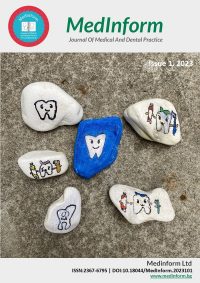Issue One 2023
2023, Vol. 10, issue 1, (January)
Original Article
Prevalence of dental caries in children with Silver-Russell syndrome
Abstract:
Silver-Russell syndrome (SRS) is a rare hereditary disease that manifests itself in fetal growth retardation during pregnancy, delayed growth after birth, a relatively large head relative to the body, a triangular face shape, a prominent forehead (when viewed in profile), body asymmetry and significant feeding difficulties at a young age. Children with Silver-Russell syndrome have smaller linear facial dimensions and abnormalities in facial proportions, such as a small, retropositioned, and steeply inclined maxilla and mandible, and proportionally greater anterior facial height relative to posterior facial height. The aim of this article is to examine the prevalence of caries lesions in children with Silver-Russell syndrome. The subject of the study were 60 children with Silver-Russell syndrome. The children were divided into three groups, according to age (<6years, 6-12 years, 12-18 years). The prevalence of caries was measured using the dft/dmf (t+T)/ DMFT indices. The prevalence of caries lesions for the children with Silver-Russell syndrome is 4,55±1,86. There is a significant prevalence of D1 and D2 caries lesions in the age group above 12 years old. (p=0.001) For the age group <6 years there is significance in the prevalence of D4 caries lesions. (p=0.007). Children with SRS have a higher prevalence of dental caries as a result from different predisposing factors, which include excessive crowding due to micrognatia, frequent carbohydrate intake due to hypoglycemia. Another reason for increased dental caries prevalence is the deficiency of vitamin D3, which is observed in children with growth hormone deficiency.
Keywords: caries, children, Silver-Russell syndrome

